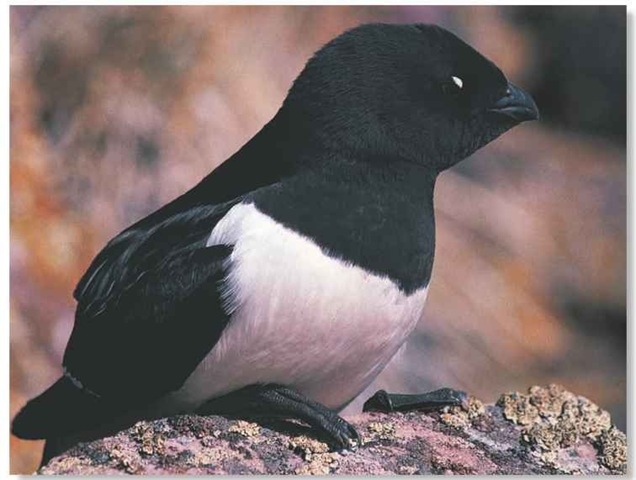ORDER
Charadriiformes
FAMILY
Alcidae
GENUS & SPECIES
KEY FEATURES
• A small seabird that swims around the Arctic pack ice, its numbers counted in millions
• Eats animal plankton, which it pursues underwater, using its wings and paddle-like feet
• Raises its single chick in teeming, noisy colonies located on remote northern coasts
WHERE IN THE WORLD !
Breeds on land within the Arctic Circle, including parts of Greenland, Iceland and northern Siberia; winters at sea, mainly in the North Atlantic
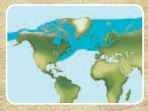
Lifecycle
Restless and gregarious, the dovekie brings life to the High Arctic summer, as nutrient-rich seas and all-day sun promote an abundance of the plankton on which it feasts.
HABITAT

A Frozen north The dovekie breeds in areas far from humans.
The dovekie spends most of its life at sea, in freezing conditions that would kill a human swimmer in minutes. Its main haunts are the cold, food-rich currents of the Arctic and North Atlantic Oceans. Even in the harshest winters, it keeps well to the north of the warmer, mid-Atlantic waters.
The dovekie comes to land only in the breeding season, living in such bleak areas as northwestern Greenland and the Franz-Josef-Land islands, which lie closertothe North Pole than to the northern coasts of Europe or North America. Nesting colonies are established on slopes close to the seas that fringe the polar ice cap.
CONSERVATION
The dovekie is one of the most abundant seabirds, with a breeding population of about 12 million pairs. Although hunted both for food and for feathers in northern Greenland, it suffers little from human disturbance. Climati c warming has caused it to abandon some smaller, more southerly colonies.
# The dovekie, or “little dove,” was ‘ given its name by Scandinavian whalers. In the U.K., it is known as the little auk.
# The droppings that amass beneath dovekie colonies enable mosses and even lush grass meadows to flourish.
# Severe gales result in sporadic “wrecks” of dovekies on far shores. In 1983, more than 1,200 of the birds were found dead on the eastern coasts of Britain, and many others were blown far inland.
BREEDING
Huge numbers of dovekies throng the breeding grounds in the High Arctic during the brief polar summer Colonies are divided into “neighborhoods” of a few hundred pairs, which behave independently of one another, establishing communal areas on nearby rocks where birds not on duty at their nests assemble to preen.
The dovekie breeds mainly on scree-covered slopes. Courting birds indulge in head-shaking and bowing, and present stones to each other when selecting a nesting hollow. The single, large egg is laid on a small bed of pebbles and is incubated by both sexes.The chick is reared on plankton and brooded continuously for the first few days. The young bird fledges after about four weeks, at which point it closely resembles its parents in size but has a browner plumage.
BEHAVIOR
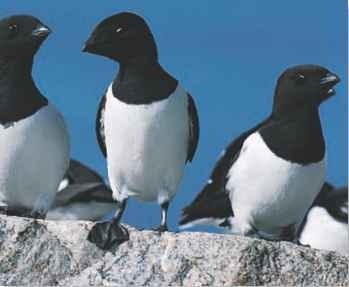
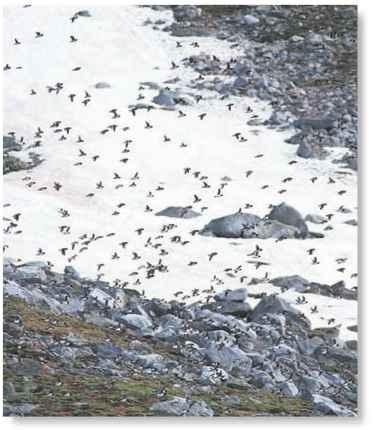
A Off to lunch
The sky above the breeding colony is alive with thousands of dovekies.
The dovekie leaves its nesting site in August to follow the broken edge of the pack ice, which creeps southward during autumn, in order to winter far out to sea. The most important areas are off Newfoundland in eastern Canada and in the Norwegian Sea, between Scandinavia and Iceland. Even in winter the auk remains sociable, roosting on the sea in large flocks, known as rafts.
For all its hardiness, the dovekie can still fall victim to the weather. Although it withstands intense cold, it suffers when storms drive plankton to unreachable depths. In its weakened state, it is at the mercy of the winds, which may blow it beyond the southerly limits of its range.
Safety in numbers By joining a large flock or colony, a dovekie increases its chances of locating food and avoiding predators.
FOOD & HUNTING
The sea provides all of the dovekie’s food. Like the baleen whales, the bird thrives on tiny planktonic animals, which in turn feed on microscopic plant organisms that bloom in the polar seas. Clouds of plankton drift just beneath the water’s surface, and the dovekie simply has to open its wide mouth to feed. It occasionally varies its diet with small fish, mollusks and aquatic worms.
Most feeding takes place at night, at least during the breeding season, as the sun dips toward the horizon and the plankton rises closer to the surface. The dovekie’s favorite foraging sites are the narrow channels between slabs of pack ice. Powered by its narrow, oarlike wings, it stays submerged for about 30 seconds on each feeding dive, reaching depths of up to 60′. It eats the catch at once unless gathering food for its young, in which case it packs its throat pouch.
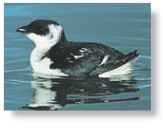
A Prepare to dive The dovekie surfaces before diving, in non-breeding plumage.
ATTACK AT SEA
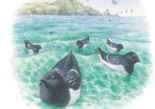
1 Buoyant mood…
Like toy boats, dovekies bob about on the ocean waves, searching for plankton.

2 Water wings…
A dovekie submerges and begins to “fly” underwater with strong beats of its stubby wings.

3 Swoop and swallow…
Paddling feet help steer the bird into a swarm of food. It steadily gulps down mouthfuls of tiny prey.
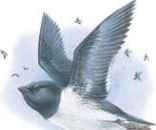
4 Ride the wind
The hunter flies back to its nest with its throat pouch brimming full of food for its chick.
PROFILE
Dovekie
Dense, waterproof plumage and thick layers of body fat help to insulate the dovekie from its harsh, icy environment.
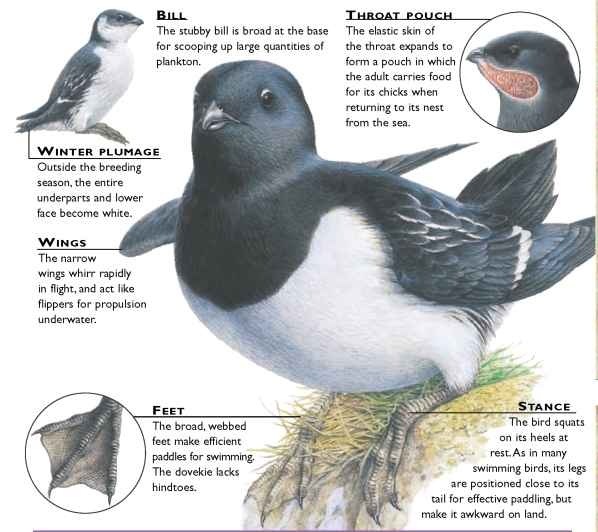
CREATURE COMPARISONS
While the dovekie feeds on plankton just below the surface of the ocean, its larger cousin,
the black guillemot (Cepphus grylle), hunts on the seaweed-covered beds of shallower
waters closer to shore. A powerful swimmer, it catches crabs, prawns and fish in
its delicate, slender bill. Like the dovekie, the black guillemot lives in the ^
High Arctic, although its breeding range stretches farther south,
encompassing northern Britain. In winte^the black guillemot
loses its pied plumage; its head and belly
become mostly white, with upperparts
speckled gray, brown and white. Dovekie Black guillemot
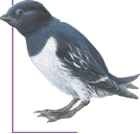
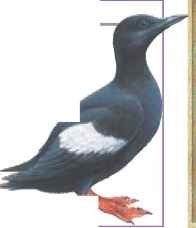
| VITAL STATISTICS | ||
| Weight | 5-6.7 oz. | |
| Length | 6.8-7.5″ | |
| Wingspan | 16-19″ | |
| Sexual Maturity | Unknown | |
| Breeding Season | June-Aug. | |
| Number of Eggs | 1 | |
| Incubation Period | 29 days | |
| Eledging Period | 28-31 days | |
| Typical Diet | Animal plankton | |
| Lifespan | Unknown | |
RELATED SPECIES
• The dovekie is a member of the Alcidae family, which also includes the Atlantic puffin, Fratercula arctica, common guillemot, Una aalge, and razorbill, Alca torda (below). Dovekies belong to the order Charadriiformes, as do gulls, plovers and waders.

